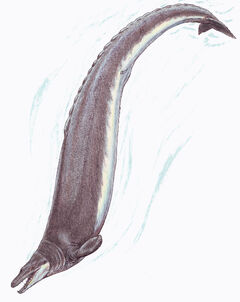
Reconstruction of Basilosaurus, the best-known and earliest-discovered zeuglodon (Source).
Basilosaurs, usually still called zeuglodons in cryptozoology, were members of the cetacean family Basilosauridae, which lived during the Middle and Late Eocene (~45—33 MYA).
Zeuglodons have frequently been considered relevant to the mystery of sea serpents, initially due to the Hydrargos hoax, and later as a genuine identity for sea serpents. This possibility was briefly raised by botanist Matthis Jakob Schlieden in 1846, but was not fully examined until A. C. Oudemans and J. G. Wood during the 1880s.[1] Since then, cryptozoologists, most notably Bernard Heuvelmans, Roy P. Mackal, Karl Shuker, have suggested zeuglodons or related early cetaceans as identities for various sea serpents and lake monsters, mainly due to their eel-like shapes,[2][3] although Heuvelmans often theorised with the mistaken belief that zeuglodons were armour-plated animals.[4]
Notes and references[]
- ↑ Heuvelmans, Bernard (1968) In the Wake of the Sea-Serpents, Hart-Davis, ISBN 9780246643124
- ↑ Eberhart, George M. (2002) Mysterious Creatures: A Guide to Cryptozoology, ABC-CLIO, Inc., ISBN 1576072835
- ↑ Coleman, Loren & Clark, Jerome (1999) Cryptozoology A to Z: The Encyclopedia of Loch Monsters, Sasquatch, Chupacabras, and Other Authentic Mysteries of Nature, Simon & Schuster, ISBN 978-0684856025
- ↑ Shuker, Karl P. N. (2016) Still In Search Of Prehistoric Survivors: The Creatures That Time Forgot?, Coachwhip Publications, ISBN 978-1616463908
